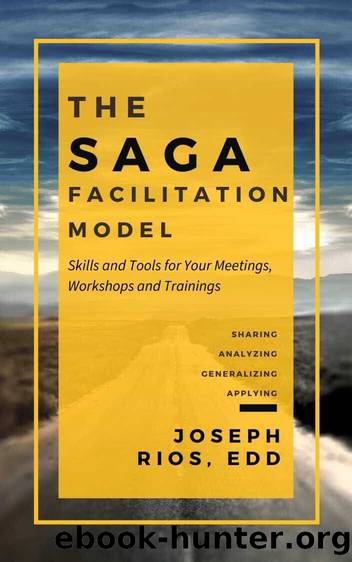The SAGA Facilitation Model: Skills and Tools for Your Meetings, Workshop, and Trainings by Rios Joseph

Author:Rios, Joseph [Rios, Joseph]
Language: eng
Format: epub
Publisher: Leadership and Values in Action, LLC
Published: 2020-06-30T16:00:00+00:00
“Every change begins with a vision and a decision to take action.”
David Bornstein
Applying Facilitation Skills to Any Meeting, Workshop or Experience
F or anyone about to embark on a journey, you need to make sure you have a trustworthy map. Or at least a sense of how to use the landmarks around you to know you’re staying on course. Those making a journey will ask in advance “what should I look for and what does the it sound like when I arrive at the destination?” Similarly, a good facilitator will have put the time into creating the journey and share this information with fellow facilitators also on the journey.
Facilitators create an environment where a number of outcomes are happening. You are responsible for keeping the discussion focused and the participants engaged. You ask questions that advance the conversation and work toward the deepest understanding possible. A good facilitator listens to participants and continues to invite all voices to share thoughts and beliefs. You care create an environment of trust and support so disagreement and understanding can surface. And you leave participants challenged and willing to engage in follow-up conversations.
That is no small feat!
With all of this work, it is critical to know a little bit more about how to stage a facilitation, prepared to do all of this work. The more you prepare for the possibilities, the better and more engaged you can stay with the people who are part of your group.
As shared before, the order in which you ask questions can be as important as the questions themselves. Imagine that in facilitation you are constructing a building with your group members. The answers they provide to your questions, and the learning that takes place, are the bricks; the questions are the scaffolding that allows you to build higher and higher. You have to start at the bottom and work your way up.
By using the SAGA model, you are helping the group by preparing the scaffold In order to continue building, you need to start with the initial questions about the topic (Sharing), then move to what the concepts mean (Analyzing) and how they work in the real world (Generalizing), before ending with a play for how to use the lessons learned (Applying).
But the scaffolding can begin with the very start of the event or activity. This section will address some of the ways you can better prepare yourself to manage the meeting, workshop or experience and still stay grounded in the facilitation. Nothing beats experience to help you learn, but I hope to share a few tips to prepare you for the possibilities.
Download
This site does not store any files on its server. We only index and link to content provided by other sites. Please contact the content providers to delete copyright contents if any and email us, we'll remove relevant links or contents immediately.
| Conflict Resolution & Mediation | Human Resources & Personnel Management |
| Knowledge Capital | Outsourcing |
Bullshit Jobs by David Graeber(3226)
Radical Candor by Kim Scott(2256)
I Am Right, You Are Wrong by Edward De Bono(2113)
23:27 by H. L. Roberts(1904)
Nomadland by Jessica Bruder(1703)
Average Is Over by Tyler Cowen(1548)
High-Impact Interview Questions by Victoria A. Hoevemeyer(1410)
Out of Our Minds: Learning to Be Creative by Ken Robinson(1386)
The Conflict Resolution Phrase Book by Barbara Mitchell & Cornelia Gamlem(1359)
The Ideal Team Player by Patrick M. Lencioni(1334)
An Everyone Culture: Becoming a Deliberately Developmental Organization by Robert Kegan & Lisa Laskow Lahey(1321)
The Asshole Survival Guide by Robert I. Sutton(1294)
Automatic Society by Bernard Stiegler(1231)
Unleashed by Anne Morriss & Frances Frei(1228)
Who by Street Randy & Smart Geoff(1205)
42 Rules of Employee Engagement by Susan Stamm(1197)
Who Moved My Cheese?: An Amazing Way to Deal With Change in Your Work and in Your Life by Johnson Spencer(1190)
96 Great Interview Questions to Ask Before You Hire by Paul Falcone(1142)
The Power of Disability by Al Etmanski(1086)
